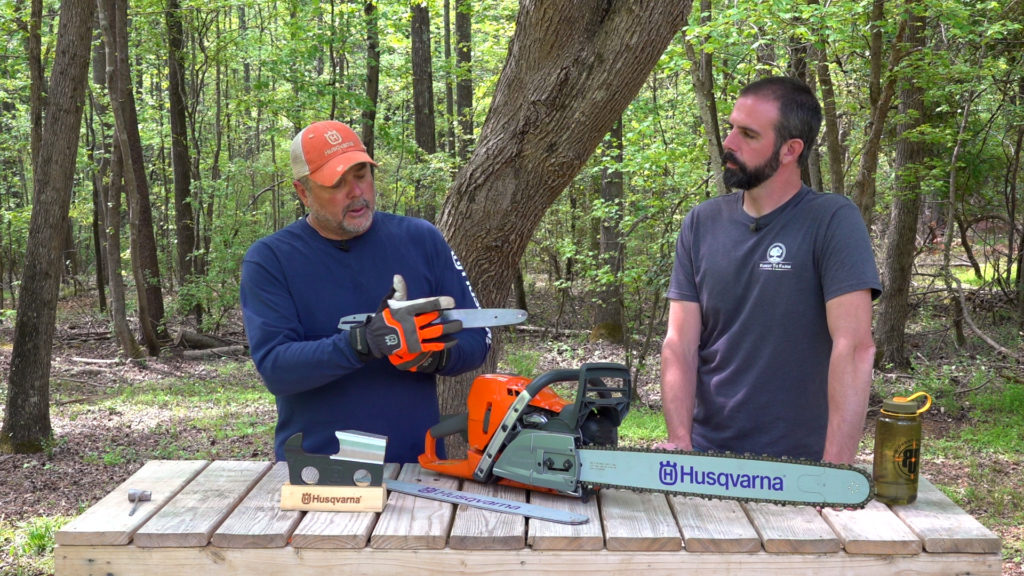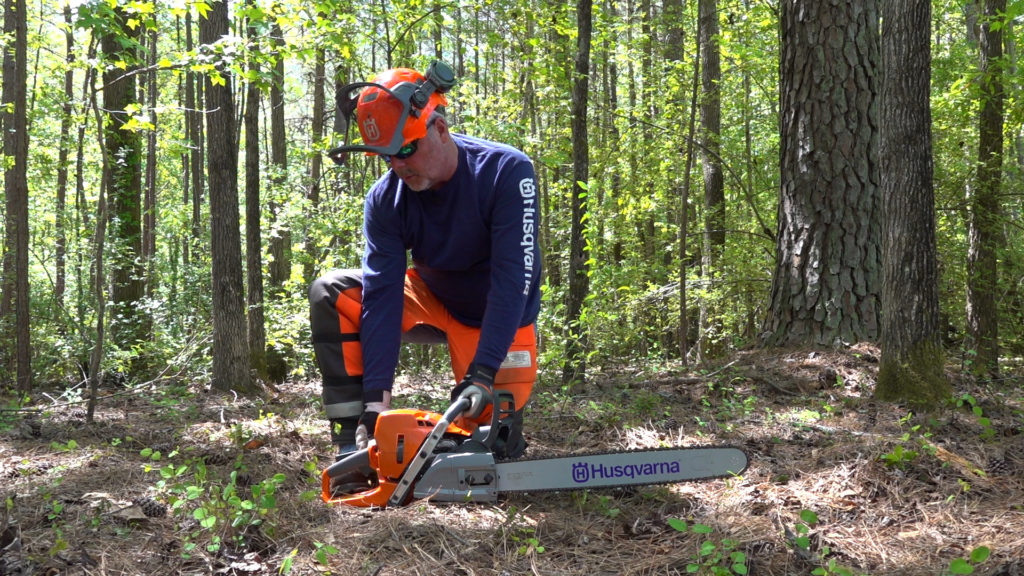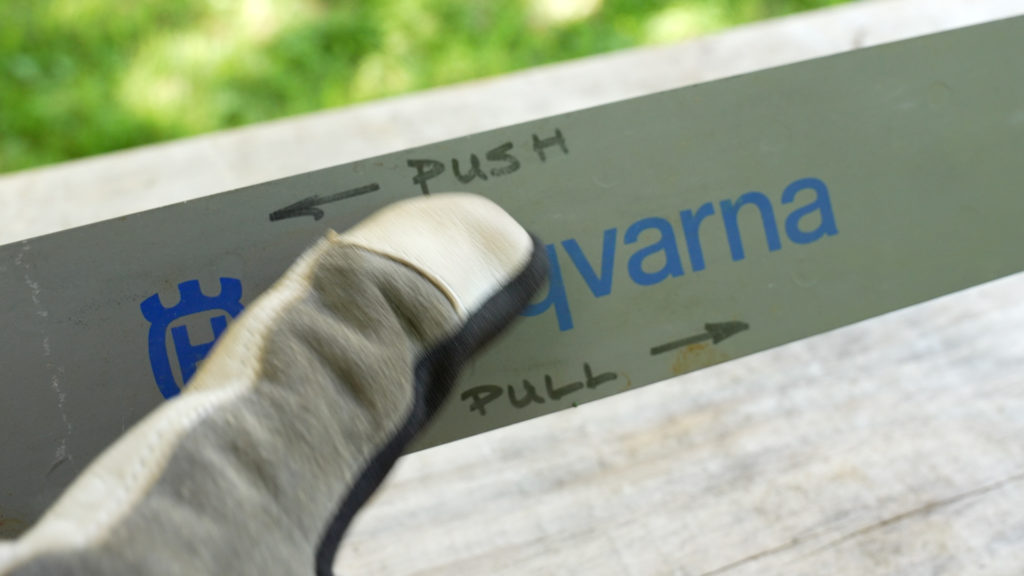
Welcome back guys! Brian & Terry here with The Forest to Farm Project. We are back with our seventh and final installment in the 7-part series on PPE with Scott from Husqvarna, and today we’ll be discussing different reactive forces you might encounter when operating a chainsaw.

The Expert:
- Name: Scott Martin
- Profession: Husqvarna Training & Sales Knowledge
- Time on The Job: 25 Years
When people talk about reactive forces the first thing that comes to mind is “kickback”, but there are more things that can happen than just that. There are three main things to look for. So, let’s look at those forces and why they are important to know.
If you look at this chainsaw bar, you’ll see “Push” with an arrow pointing backwards and “pull” with an arrow pointing forwards. I’m sure you’ve heard the term “For every action, there is an equal and opposite reaction”. Now, let’s think of the chainsaw in those terms.
Imagine you have the saw running and the chain is moving at 60 mph (yes, it’s really that fast), and for some reason the chain is stopped on top of the bar (maybe you’re doing an undercut and the chain gets pinched). Well, the chain was moving away from you. If it comes to a sudden stop that energy pushing the chain 60 mph has to go somewhere. So, it’s going to PUSH the saw back at you because there is a lot of inertia and momentum going on there. The purpose in knowing how the saw will react here is that, when you are in that type of situation, you don’t want to be sawing with the saw out away from your body. With the saw away from your body, you leave a lot of room for the saw to push back into and you have a greater area where you don’t have complete control of the saw. What you should be doing is have the saw pulled in closer to your body where you have much better control over it. Not to mention, running a heavy saw out away from your body puts a lot of undue stress on your lower back and will rapidly increase your fatigue levels.

Now, let’s look at the “pull” forces. Here, would be your normal cutting method with using the bottom of the bar. In this scenario, if the chain that’s moving at 60 mph comes to a complete and sudden stop, the saw will lunge forward very quickly. If you don’t have a good, secure grip on the top handle and rear grip there’s a good chance the saw could come out of your hands. This is one of the many reasons to be sure and wear gloves when operating a chainsaw. By wearing gloves, you will have a better grip because your sweaty hands won’t be a slick on the handle as they would be without gloves. Additionally, you want to make sure you are utilizing a full grip with your left hand, one where your thumb is properly wrapped behind the handle.
Now let’s discuss the most talked about reactive force, kickback. In the above photo, you will see a small, blackened area at the tip of the bar. This is what’s known as the “kickback zone”. People often are mistaken and say that you cannot cut with the tip of the bar. That’s just not true. You can cut with the tip, very effectively; and there several instances where you have to use the tip to do the job, plunge cutting for one. The trick is, knowing how to approach the situation. The blackened area of the bar represents about a 45-degree area where kickback primarily occurs. Once you pass that zone, as long as the chain is in good shape, you’re not really at risk for kickback.
When you look at the design of a chain you have a few different parts: Top plate with the cutter tooth, gullet, depth gauge (raker) and a couple of rivet holes. In most chains, the distance between the depth gauge and the cutter tooth is .025”, or twenty-five thousandths of an inch, a very tiny space. So, with each pass of a tooth, you are removing .025” of wood. So, if the depth gauge is not kept in balance with the cutter tooth, you could end up with .030” or more. You could get to a point that it’s too much for the saw to process in one pass. You can think of it like an old wood plane where you adjust the blade depth by hand. If you adjust the blade down too much, you can’t move the plane because it just digs in.
So now, imagine you’re running along and when you get to the tip of the bar, that chain link goes from cutting .025” to now having an opening that is 3/8” wide which is far too much for the saw to process bringing the chain to a sudden and complete stop. This gives you a reactive force that pushes the saw up and back, away from the cutting tip…” kickback”. That’s why this is known as the “kickback zone”.
If you need to cut with the tip, you can start with the bottom and rotate the saw in once you have made contact. This will allow you to make a plunge cut through the wood.
Lastly, let’s look at different bar types and their impact on reactive forces. Different saws require different radiuses on the tip. That bend is a point of friction, so it generates heat. The tighter the radius, the more heat that’s generated and the bearing system can only displace so much heat at one time. The more powerful and faster a saw is, the larger the radius of the tip needs to be in order to handle the heat being generated. Now, if you look the picture again, you’ll see that the area where kickback can occur is going to be a bit bigger on a larger radius bar. So, that’s something to keep in mind as you use different size saws/bars.
We hope you found this PPE series with Scott from Husqvarna to be informative and helpful when it comes to picking out your PPE or when you are starting and using your saw. There’s so much to keep in mind when you’re doing something like this, but it’s worth the investment of time and/or money to make sure you’re safe. Thanks for following along and check back soon for more great content!
